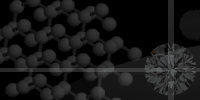


|
Introduction to Carbon Allotropes Carbon is an important element in chemistry. There are about sixteen million compounds of carbon, more than for any other element. There are three allotropes of carbon as well as other stable forms. In the third dimension there is diamond, which is a semi-conductor, in the second dimension, graphite, and in the first dimension nanotubes exist which can be conductors of semi-conductors. Finally there are fullerenes, which are in the zero dimension and have unusual properties. Thus a large part of chemistry is concerned by interactions of carbon and therefore of organic molecules. Carbon is found in the fourteenth group in the periodic table so its electronic structure is 1s2 2s2 2p2. Carbon can exist in interesting hybridisations and form several different types of bonds. Carbon is a central part of life and without carbon we could not exist. This is why it is essential for the pharmaceutical industry in research for new medication and to understand an illness and its treatment. Furthermore, a large part of the diagram of phases of carbon is still unexplored so the chemical world awaits the discovery of more novel forms of carbon. In this web project, I will introduce carbon, describe its allotropes, present buckminsterfullerene, address the ideas which followed and finally the uses of these allotropes and their compounds.
Home ||
Diamond ||
Graphite ||
Buckyballs ||
Nanotubes ||
Fullerenes
Samantha Shanley, School of Chemistry, University of Bristol |
